 
|

|
|
November 24, 2007 Ponduru, Srikakulam District, Andhra Pradesh
I had expected not more than a remote village, Ponduru was quite bustling with rikshaws and vehicles bumping along a main road lined with shops and stands selling just about everything. The taxi driver brought us right to the administration office of the Ponduru Khaddi guild. Since we couldn't speak Telugu we were guided to a clerk who speaks a sweet Telugu infused Hindu who told us all the pertinent facts about how the hand spinning process works. 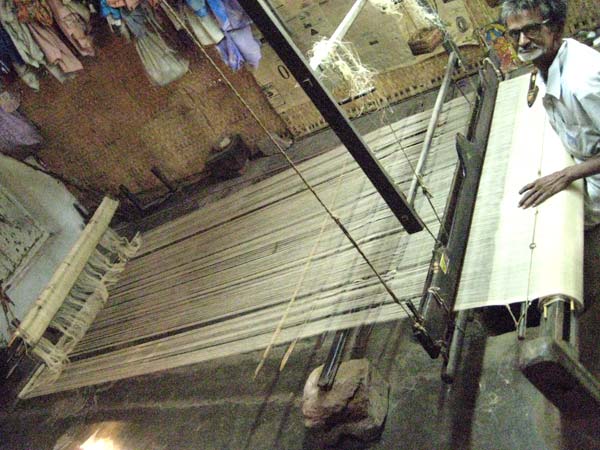 Ponduru is not a good place to buy sarees - the real ones, not the power spun duplicates to be found all over this region, are incredibly expensive - 10 times what I would normally pay for a cotton sari. Between carding, spinning and weaving it takes 3 weeks for one sari! 1,000,000 yards of hand spun yarn is required for a 6 yard sari. The finest examples are 120 x 120 counts per inch. That means the wide 52" sarees have 6240 ends to tie up on the loom, and 26,000 weft threads to weave. The weaving itself of a simpler sari takes a week. Two weavers sit at the loom in a pit dug into the floor of the hut. Support post are driven into the earth and the warp is tied to a take up beam and a warp beam that is suspended by strings to an anchor in the wall or post the loom. The weavers service two sets of foot pedals that control the main shed and border designs, which are tied up with string heddles - usually very simple mango or flower motifs. While there might be a few collectors willing to pay the price for these optically very plain pieces, on my limited buying budget it didn't make sense to get any at this time.
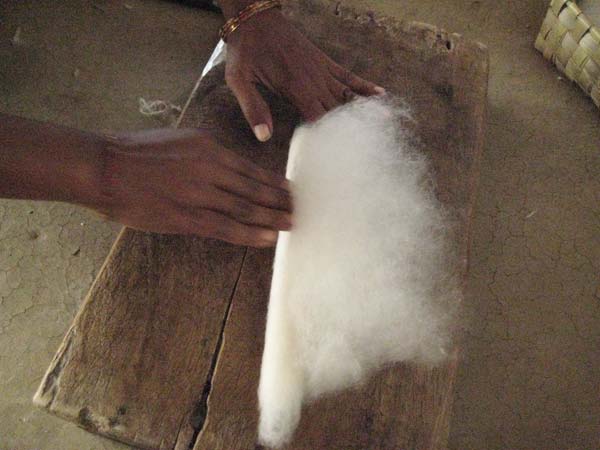 The spinner takes the metal rod and carefully rolls the bat into a flat square shape. More manual inspection of the fibers and removing of any other dirt or compacted bits of fiber follows. Then the square is rolled into a tube around a thin metal rod. The rod is removed and the fiber tube is lightly sandwiched in a banana leaf.
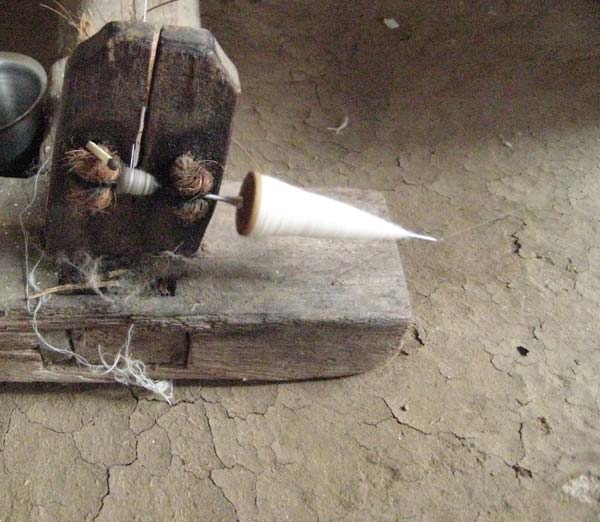 The twist from the spindle and a slight backward pulling of the left hand pulls the fibers out from the roving. To wind the thread onto the spindle the spinner flicks her arm up and allows the thread to be fed onto it. Or uses her foot to brake the bobbin. Then she pulls back again drawing out more thread. This is all happening in a matter of seconds and proceeds with ease and grace. When the thread breaks she just holds the end near the roving and starts the wheel again and the break joins in with spin and draws out more thread. Mr. Rao showed us the tight little thousand yard hanks that can be made in one day, for which the spinner gets 25 rupees. It is not much money for a day of painstaking work. The women are always at their wheels, quietly spinning day in and day out. As we sat there under the cool shade of a palm frond overhang enjoying the peace of the wheels turning and the women's gentle company a naughty child got into a basket of fiber tubes and destroyed one. Everyone chimed in and he was fiercely punished by mom. That is a big no-no in the life of a Ponduru spinner family! I can imagine staying in Ponduru for weeks and letting the peace of the place, and the warmth of the villagers wash over me. With time I might even get a chance to try spinning myself!
Back to the textile tour start page All images and text © Sarisafari |
|
Sitemap How to drape a sari Sari facts and fun Collection Overview |

|
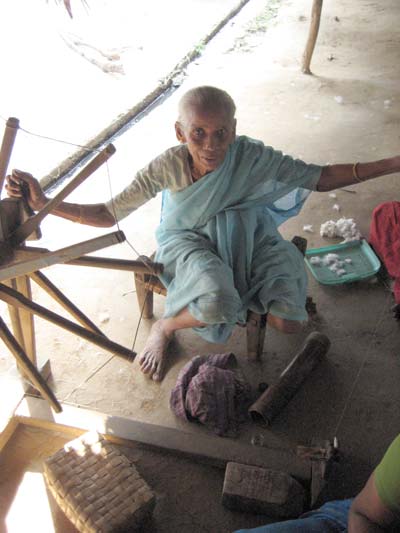 Ponduru is famed for it's complete hand spinning processes. Normally most cotton in India is machine carded, that means the fibers are combed and mechanically separated from the seeds and rendered into fluffy bats for the hand spinners. In Ponduru every step is still done by hand!
Ponduru is famed for it's complete hand spinning processes. Normally most cotton in India is machine carded, that means the fibers are combed and mechanically separated from the seeds and rendered into fluffy bats for the hand spinners. In Ponduru every step is still done by hand!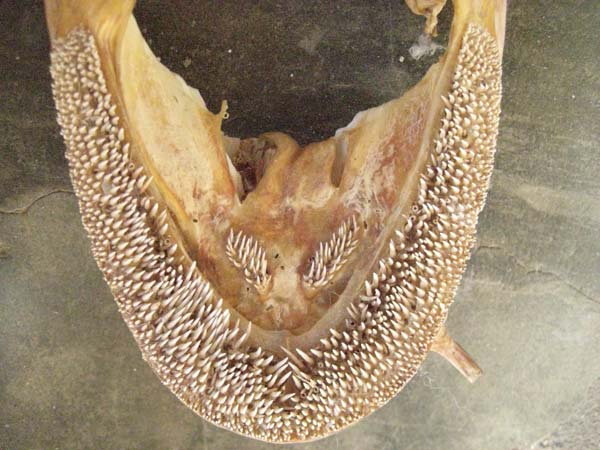 After the lunch break we could see the entire spinning process demonstrated. The cotton bolls are carefully separated from their seeds, first by combing them in an outward direction with a fish jaw bone. This particular fresh water fish has rows of tiny needle like teeth and the dried jawbones are cut into serviceable sized pieces and anchored to a stick with string. These tools can be used daily for almost a year and a half before they have to be replaced. Only this one type of fish jaw will work so well and last so long. Unfortunately these fish are becoming harder and harder to come by.
After the lunch break we could see the entire spinning process demonstrated. The cotton bolls are carefully separated from their seeds, first by combing them in an outward direction with a fish jaw bone. This particular fresh water fish has rows of tiny needle like teeth and the dried jawbones are cut into serviceable sized pieces and anchored to a stick with string. These tools can be used daily for almost a year and a half before they have to be replaced. Only this one type of fish jaw will work so well and last so long. Unfortunately these fish are becoming harder and harder to come by. 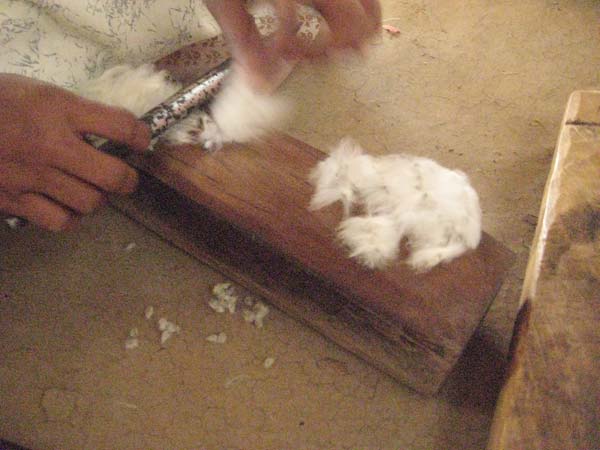 After combing the bolls, they then have a row of seeds concentrated in the middle with combed out cotton fuzz on either side. These are then rolled on a wooden tray with a tapered metal pin which carefully removes the seeds from the cotton. Unlike mechanized carding, the seeds are still intact and can be used to plant in the next season. This fluff is then flattened out and all dirt and debris are carefully removed by hand.
After combing the bolls, they then have a row of seeds concentrated in the middle with combed out cotton fuzz on either side. These are then rolled on a wooden tray with a tapered metal pin which carefully removes the seeds from the cotton. Unlike mechanized carding, the seeds are still intact and can be used to plant in the next season. This fluff is then flattened out and all dirt and debris are carefully removed by hand. 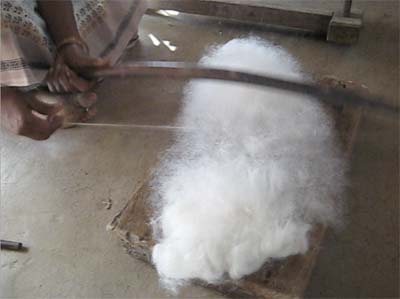 To be able to spin this short staple cotton into such incredibly fine fibers requires proper preparation of the batts. A type of bow is used to separate the fibers and recombine them in opposite directions. The bow string is placed in the handful of combed fiber and plucked. A sweet sounding tang tang tang and the fibers magically fluff up and align themselves in the direction of the string. After all is carefully fluffed out the fibers are turned 90 degrees and this is repeated. The fibers are now completely interlocked and have 10 x their original bulk.
To be able to spin this short staple cotton into such incredibly fine fibers requires proper preparation of the batts. A type of bow is used to separate the fibers and recombine them in opposite directions. The bow string is placed in the handful of combed fiber and plucked. A sweet sounding tang tang tang and the fibers magically fluff up and align themselves in the direction of the string. After all is carefully fluffed out the fibers are turned 90 degrees and this is repeated. The fibers are now completely interlocked and have 10 x their original bulk. 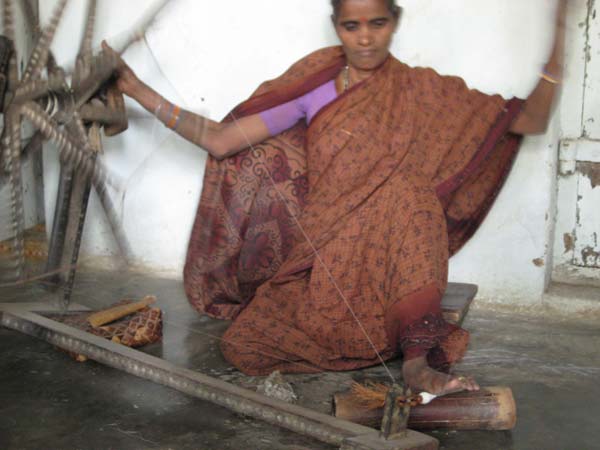 Very simple spinning wheels made of wooden spokes radiating out from an axle are used in this village. These spokes are tied together at the circumference with heavy string. A drive band of more string goes around this string and turns a simple metal spindle. The wheel is driven by a crank at the axle with the right hand, the left hand holds the bat in the banana leaf. The spinners work so fast that it is very difficult to actually see how they manage to make such miraculously fine thread. It's completely a matter of feeling and experience as to how fine of a fiber is spun. Watching them it's seems to be closer to magic, than craft. It is actually quite amazing that the spinners can make a thousand yards of fine thread in a day.
Very simple spinning wheels made of wooden spokes radiating out from an axle are used in this village. These spokes are tied together at the circumference with heavy string. A drive band of more string goes around this string and turns a simple metal spindle. The wheel is driven by a crank at the axle with the right hand, the left hand holds the bat in the banana leaf. The spinners work so fast that it is very difficult to actually see how they manage to make such miraculously fine thread. It's completely a matter of feeling and experience as to how fine of a fiber is spun. Watching them it's seems to be closer to magic, than craft. It is actually quite amazing that the spinners can make a thousand yards of fine thread in a day. 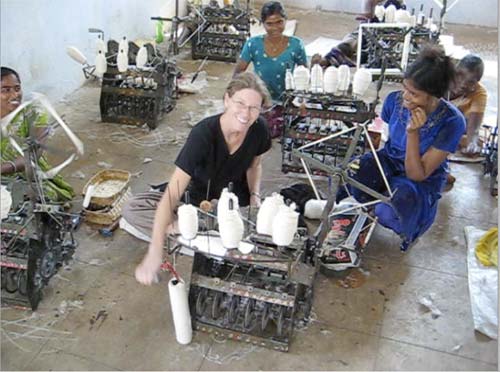 We went to a machine spinning hut and visited the ladies all madly cranking on mechanized spinning machines. They were all laughing and smiling at us rare western visitors. One sweet young woman let me try to operate her machine, which spins 6 spindles of yarn at a time. She only gets 1.75 rupees for a hank of this mechanically spun yarn, but the machine allows her to make a 15 or so per day. The yarn is not as fine as what can be made by hand and lacks the texture and absorbency of pure handspun but it can also produce beautiful 70 - 80 counts cloth.
We went to a machine spinning hut and visited the ladies all madly cranking on mechanized spinning machines. They were all laughing and smiling at us rare western visitors. One sweet young woman let me try to operate her machine, which spins 6 spindles of yarn at a time. She only gets 1.75 rupees for a hank of this mechanically spun yarn, but the machine allows her to make a 15 or so per day. The yarn is not as fine as what can be made by hand and lacks the texture and absorbency of pure handspun but it can also produce beautiful 70 - 80 counts cloth.